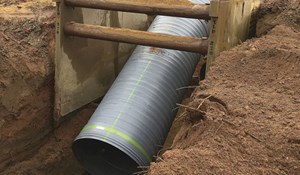Stormwater Needs Survey Shows $7.5B Annual Funding Gap
A recent analysis of needs of the U.S. stormwater sector shows an estimated $7.5 billion annual funding gap and revealed top priorities and challenges across the country.

The inaugural MS4 Needs Assessment Survey led by the Water Environment Federation's (WEF) Stormwater Institute, reflects an effort to learn more about the nature and needs of the MS4 sector at a scale that has never been attempted.
The survey generated some significant and surprising findings:
- Phase I and II (municipal and non-traditional) permittees ranked regulatory compliance, local flooding, and water quality and habitat restoration issues as important program drivers.
- The most significant challenges as identified are lack of funding, aging infrastructure, and evolving regulations.
- Respondents indicated the greatest need for information and technical resources is related to funding and financing. In addition, there is a need for technical information and products on green infrastructure practices and innovative techniques/technologies, as well as information related to asset management.
- An unexpected finding is the lack of priority by respondents regarding climate change, which points to the need to highlight how changing precipitation patterns will impact MS4s in the future.
"An important first step in a maturing infrastructure sector is to better understand the fundamental challenges and needs," said WEF Executive Director Eileen O'Neill. "This survey and analysis represent this first major step in the stormwater sector, which is a field that is notoriously data-poor. By collecting data on the MS4 sector, this effort identifies the priorities that need to be addressed in the near term while allowing for planning for coverage of other areas in a long-term strategic fashion."
The survey received 622 responses from 48 states and the District of Columbia. Approximately 25 percent and 65 percent of respondents represented Phase I and II MS4 permittees, respectively. Non-traditional Phase II permittees and state transportation departments accounted for 7 percent and 3 percent of the survey sample, respectively. This statistically significant sample is also generally representative of the distribution of MS4s across the U.S.
Stormwater is the only growing source of water pollution in many waterways across the country. With urban populations expected to grow to nearly 70 percent by 2050, and more frequent and intense storms occurring across the country, there is ever-increasing pressure on stormwater systems and water infrastructure.
WEF is a not-for-profit technical and educational organization of 35,000 individual members and 75 affiliated Member Associations representing water quality professionals around the world.
Related News
From Archive

- Glenfarne Alaska LNG targets late-2026 construction start for 807-mile pipeline project
- U.S. water reuse boom to fuel $47 billion in infrastructure spending through 2035
- $2.3 billion approved to construct 236-mile Texas-to-Gulf gas pipeline
- Major water pipe break in Puerto Rico hits over 165,000 customers
- Potomac River Tunnel project enters construction phase beneath Washington, D.C.
- Pennsylvania American Water launches interactive map to identify, replace lead water service lines
- Trump's tariffs drive $33 million cost increase for Cincinnati sewer project
- Utah city launches historic $70 million tunnel project using box jacking under active rail line
- Tulsa residents warned after sewer lines damaged by boring work
- Fatal trench collapse halts sewer construction in Massachusetts; two workers hospitalized



Comments